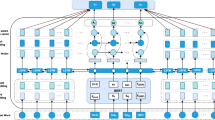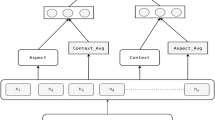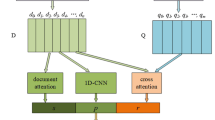Abstract
Aspect-Based Sentiment Classification (ABSA), predicting the sentimental tendency towards given aspects, is an important branch in natural language understanding. However, in the existing deep learning models for ABSA, there is a contradiction between the fine sentiment analysis and the small amount of corpus. To solve this contradiction, we propose a BERT-based Multi-Semantic Learning (BERT-MSL) model with aspect-aware enhancement for aspect polarity classification, which follows the Transformer structure in BERT and uses lightweight multi-head self-attentions for encoding. First, we make full use of the extensive pre-training and post-training of the BERT model to obtain the initialization parameters with rich knowledge for our BERT-MSL model, so that our model can be quickly adapted to the ABSA task only by fine-tuning on a small corpus. Second, to achieve the fine sentiment analysis centered on aspect target, we propose a BERT-based multi-semantic learning model composed of the left-side local semantic, right-side local semantic, aspect target semantic and global semantic learning modules, and propose an aspect-aware enhancement method based on BERT and multi-head attention. Third, we propose two alternative semantic merging methods to generate the final expressive-powerful sentiment semantics for ABSA. Furthermore, to expand the application scope of our model, we design an advanced structure for our model by introducing a CNN-based semantic refinement layer. Experimental results on five SemEval and Twitter datasets demonstrate that our model improves the stability and robustness of ABSA and significantly outperforms some of the state-of-the-art models under the BERT Post-Training (BERT-PT) environment.








Similar content being viewed by others
References
Pang B, Lee L (2008) Opinion mining and sentiment analysis. Foundations and trends in information retrieval 2(1):1–135
Liu B (2012) Sentiment analysis and opinion mining. Synthesis Lectures on Human Language Technologies 5(1):1–167
Kanayama H, Nasukawa T (2006) Fully automatic lexicon expansion for domain-oriented sentiment analysis. In: Processdings of the 2006 conference on empirical methods in natural language processing. Association for Computational Linguistics, Sydney, Australia, 22–23 July 2006, pp 355–363
Liao WX, Zeng B, Yin XW, Wei PF (2021) An improved aspect-category sentiment analysis model for text sentiment analysis based on RoBERTa. Appl Intell 51(6):3522–3533
Tang D, Qin B, Feng X, Liu T (2016) Effective LSTMs for target-dependent sentiment classification. In: Proceedings of the COLING 2016, the 26th international conference on computational linguistics: technical papers, Osaka, Japan, 11-17 December 2016, pp 3298-3307
Tang D, Qin B, Liu T (2016) Aspect level sentiment classification with deep memory network. In: Empirical methods in natural language processing, pp 214–224
Li M, Chen L, Zhao J, Li Q (2021) Sentiment analysis of Chinese stock reviews based on BERT model. Appl Intell 51(7):5016–5024
Wang Y, Huang M, Zhu X, Zhao L (2016) Attention-based lstm for aspect-level sentiment classification. In: Proceedings of the 2016 conference on empirical methods in natural language processing, pp 606-615
Ma D, Li S, Zhang X, Wang H (2017) Interactive attentions networks for aspect-level sentiment classification. In: Proceedings of the 26th international joint conference on artificial intelligence, Melbourne, Australia, 19-25 August 2017, pp 4068-4074
Song Y, Wang J, Jiang T, Liu Z, Rao Y (2019) Attentional encoder network for targeted sentiment classification. In: arXiv preprint arXiv:1902.09314
Xu Q, Zhu L, Dai T, Yan C (2020) Aspect-based sentiment classification with multi-attention network. Neurocomputing 388(3):135–143
Xu L, Bing L, Lu W, Huang F (2020) Aspect sentiment classification with aspect-specific opinion spans. In: Proceedings of EMNLP 2020, pp 3561-3567
Yang H, Zeng B, Yang J, Song Y, Xu R (2021) A multi-task learning model for Chinese-oriented aspect polarity classification and AspectTerm extraction. Neurocomputing 419:344–356
Chen P, Sun Z, Bing L, Yang W (2017) Recurrent attention network on memory for aspect sentiment analysis. In: Proceedings of EMNLP, pp 452-461
Bahdanau D, Cho K, Bengio Y (2015) Neural machine translation by jointly learning to align and translate. In: Proceedings of ICLR
Xu H, Liu B, Shu L, Yu PS (2019) BERT Post-Training for Review Reading Comprehension and Aspect-based Sentiment Analysis. In: Proceedings of the 2019 Conference of the North American Chapter of the Association for Computational Linguistics: Human Language Technologies, Volume 1, pp 2324–2335
Devlin J, Chang MW, Lee K, Toutanova K (2019) BERT: pre-training of deep bidirectional transformers for language understanding. In: Proceedings of the 2019 conference of NAACL, pp 4171–4186
Vaswani A, Shazeer N, Parmar N, Uszkoreit J, Jones L, Gomez AN, Kaiser L, Polosukhin I (2017) Attention is all you need. In: 31st conference on neural information processing systems (NIPS 2017), pp 5998–6008
Zhou J, Huang X, Hu Q, He L (2020) SK-GCN: modeling syntax and knowledge via graph convolutional network for aspect-level sentiment classification. Knowl-Based Syst 205(3):106292
Song W, Wen Z, Xiao Z, Park S (2021) Semantics perception and refinement network for aspect-based sentiment analysis. Knowl-Based Syst 214:106755
Chen Z, Qian T (2019) Transfer capsule network for aspect level sentiment classification. In: Proceedings of the 57th annual meeting of the Association for Computational Linguistics, pp 547–556
Weston J, Chopra S, Bordes A (2014) Memory networks. In: arXiv preprint Xiv:1410.3916
Wu C, Xiong Q, Yang Z, Gao M (2021) Residual attention and other aspects module for aspect-based sentiment analysis. Neurocomputing 435:42–52
He R, Lee W, Ng H, Dahlmeier D (2018) Exploiting document knowledge for aspect-level sentiment classification. In: arXiv preprint arXivL 1806.04346
Peters ME, Neumann M, Lyyer M, Gardner M, Clark C, Lee K, Zettlemoyer L (2018) Deep contextualized word representations. In: NAACL, pp 2227–2237
Radford A, Narasimhan K, Salimans T, Sutskever I (2018) Improving language understanding by generative pre-training. In: OpenAI Blog
Radford A, Wu J, Child R, Luan D, Amodei D, Sutskever I (2019) Language models are unsupervised multitask learners. In: OpenAI Blog
Rietzler A, Stabinger S, Opitz P, Engl S (2019) Domain adaptation through BERT language model finetuning for aspect-target sentiment classification. In: arXiv: 1908.11860
Liu Y, Ott M, Goyal N, Du J, Joshi M, Chen D, Levy O, Lewis M, Zettlemoyer L, Stoyanov V (2019) Roberta: a robustly optimized bert pretraining approach. In: arXiv: 1907.11692v1
Pontiki M, Galanis D, Pavlopoulos J, Papageorgiou H, Androutsopoulos I, Manandhar S (2014) Semeval-2014 task 4: aspect based sentiment analysis. In: Proceedings of the 8th international workshop on semantic evaluation(SemEval2014), Dublin, Irland,23-24 August 2014, pp 27-35
Pontiki M, Galanis D, Papageorgiou H, Manandhar S, Androutsopoulos I (2015) SemEval-2015 task 12: aspect based sentiment analysis. In proceedings of SemEval
Pontiki M, Galanis D, Papageorgiou H, Androutsopoulos I, Manandhar S, AL-Smadi M, Al-Ayyoub M, Zhao Y, Qin B, De Clercq O et al (2016) Semeval-2016 task 5: Aspect based sentiment analysis. In: Proceedings of the 10th International Workshop on Semantic Evaluation (SemEval-2016), San Diego, CA, USA, 16–17 June 2016, pp 19–30
Dong L, Wei F, Tan C, Tang D, Zhou M, Xu K (2014) Adaptive recurrent neural network for target-dependent twitter sentiment classification. In: Proceedings of ACL, volume 2, pp 49–54
Wang B, Lu W (2018) Learning latent opinions for aspect-level sentiment classification. In: Proceedings of AAAI
He R, Lee WS, Ng TH, Dahlmeier D (2018) Effective attention modeling for aspect-level sentiment classification. In: Processdings of COLING, pp 1121–1131
He R, McAuley J (2016) Ups and downs: modeling the visual evolution of fashion trends with one-class collaborative filtering. In: World Wide Web
Rajpurkar R, Zhang J, Lopyrev K, Liang P (2016) SQuAD: 100,000+ questions for machine comprehension of text. In: arXiv preprint arXiv:1606.05250
Kingma DP, Ba J (2015) Adam: a method for stochastic optimization. In: Proceedings of ICLR, vol 5
Li X, Bing L, Lam W, Shi B (2018) Transformation networks for target-oriented sentiment classification. In: Proceedings of ACL, pp 946-956
Acknowledgements
This work was supported in part by the National Natural Science Foundation of China under the contract number 62062012, the Natural Science Foundation of Guangxi of China under the contract number 2020GXNSFAA159082, the National Natural Science Foundation of China under the contract number 61967003, and Guangxi Collaborative Innovation Center of Multi-source Information Integration and Intelligent Processing.
Author information
Authors and Affiliations
Corresponding author
Additional information
Publisher’s note
Springer Nature remains neutral with regard to jurisdictional claims in published maps and institutional affiliations.
Rights and permissions
About this article
Cite this article
Zhu, X., Zhu, Y., Zhang, L. et al. A BERT-based multi-semantic learning model with aspect-aware enhancement for aspect polarity classification. Appl Intell 53, 4609–4623 (2023). https://doi.org/10.1007/s10489-022-03702-1
Accepted:
Published:
Issue Date:
DOI: https://doi.org/10.1007/s10489-022-03702-1




